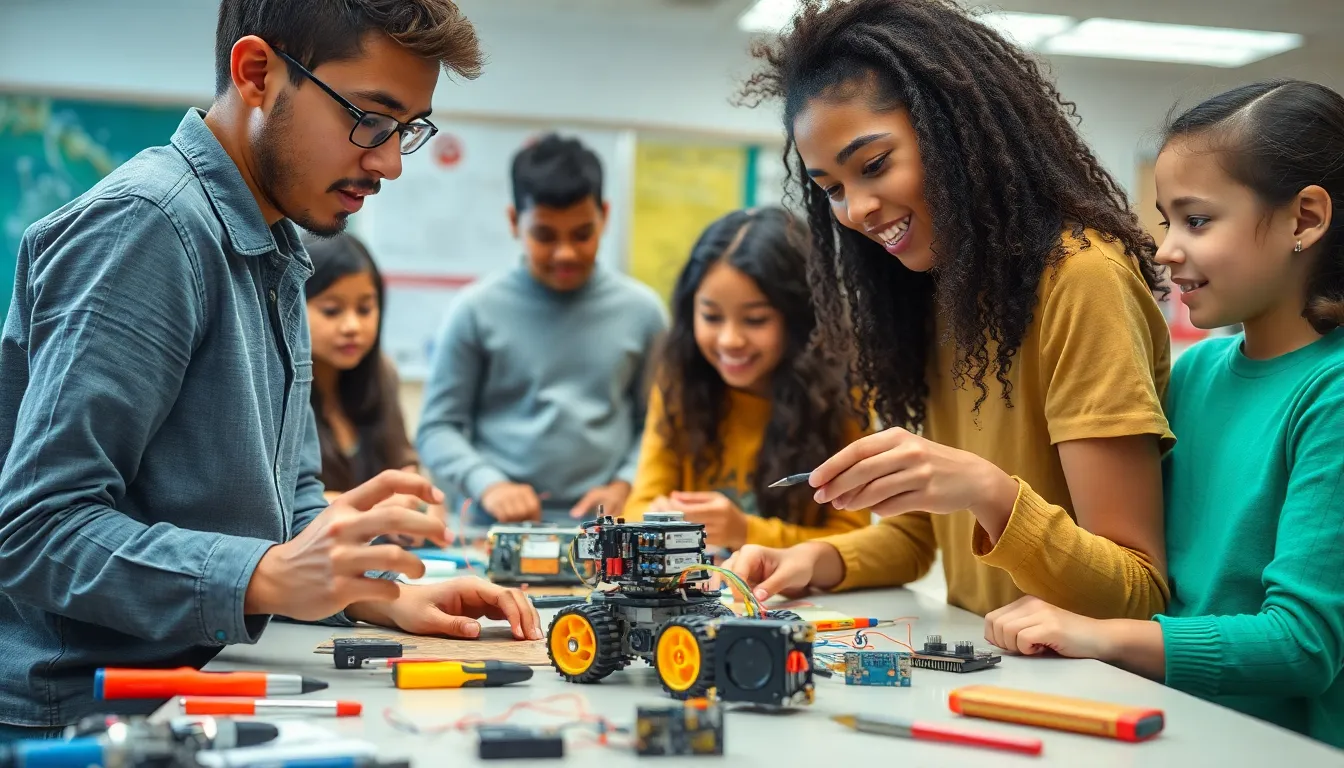Table of Contents
ToggleIn a world where technology reigns supreme, STEM education tools are the superheroes students never knew they needed. These tools don’t just teach math and science; they make learning feel like a thrilling adventure. Imagine kids coding robots to dance or using virtual reality to explore the cosmos—all while having a blast!
Overview of STEM Education Tools
STEM education tools encompass a variety of resources designed to enhance learning in science, technology, engineering, and mathematics. These tools include hands-on kits, software applications, and interactive platforms. Robotics kits allow students to build and program their own robots, fostering skills in coding, engineering, and critical thinking.
Both augmented reality (AR) and virtual reality (VR) applications provide immersive experiences that bring lessons to life. By exploring complex concepts such as the solar system, students gain a deeper understanding of astronomical phenomena. Software tools for simulations also enable learners to manipulate variables to observe outcomes, reinforcing scientific principles.
Additionally, online collaboration platforms encourage teamwork among students, promoting communication and project management skills. Integrating regularly used tools like Google Classroom enhances organization and streamlines assignments.
Data-driven platforms that provide immediate feedback help students track their progress. Gamified learning experiences engage students in subjects like mathematics and programming through fun challenges. As students interact with these tools, they develop confidence in their abilities and curiosity about STEM fields.
Workshops and maker spaces serve as physical environments where learners can experiment and innovate. Exposure to real-life applications of STEM concepts prepares students for future careers in diverse industries. Overall, these tools play a crucial role in transforming how students engage with STEM subjects, making education dynamic and relevant.
Importance of STEM Education

STEM education plays a critical role in preparing students for the future. Engaging with these topics fosters analytical thinking and problem-solving skills essential in today’s workforce.
Skills Developed Through STEM
Students develop various skills through STEM education. Critical thinking becomes a core competency as learners tackle complex problems. Collaboration occurs frequently, with teamwork fostered through hands-on projects. Creativity thrives when students design solutions or experiment with new ideas. Moreover, technical skills like coding and engineering are honed through practical applications. These experiences cultivate resilience, as students learn to troubleshoot and iterate on their designs.
Impact on Student Engagement
Student engagement significantly increases with STEM education tools. Interactive platforms capture attention and make learning enjoyable. Robotics projects draw students in with tangible results, sparking curiosity and excitement. Gamified learning experiences encourage competition, enhancing motivation and participation. Furthermore, real-world applications of STEM concepts keep learners invested in their studies. Immersive technologies like augmented and virtual reality create memorable experiences that connect abstract concepts to real-life scenarios. Overall, these factors contribute to deeper engagement and a passion for STEM fields.
Types of STEM Education Tools
STEM education tools offer a broad spectrum of resources tailored for effective learning in science, technology, engineering, and mathematics. They engage students creatively and meaningfully.
Software and Applications
Software tools and applications play a critical role in STEM education. Simulations allow learners to manipulate variables and observe results easily. Applications designed for coding enhance programming skills while engaging students with interactive challenges. Platforms that promote collaboration encourage teamwork, allowing students to work on projects together regardless of location. Tutorials and instructional videos within these applications streamline learning by providing step-by-step guidance. Gamified apps create enjoyable experiences, which boost engagement and motivation. These tools not only reinforce core concepts but also foster a growth mindset.
Hands-on Kits and Materials
Hands-on kits and materials significantly enhance the STEM learning experience. Robotics kits enable students to build, program, and troubleshoot their creations, delivering practical coding and engineering knowledge. Science lab kits allow learners to conduct experiments, reinforcing scientific principles through real-world applications. Building sets for engineering encourage creativity as students design and construct structures, honing problem-solving skills. Crafting materials used in maker spaces provide opportunities for innovation and exploration. By employing these resources, students engage in active learning, fostering a deeper understanding of complex concepts.
Choosing the Right STEM Education Tools
Selecting suitable STEM education tools significantly impacts students’ learning experiences. Factors influencing this choice include age appropriateness, ease of use, and alignment with curriculum goals.
Factors to Consider
Age appropriateness ensures tools resonate with students’ developmental stages. Ease of use promotes engagement, as complex tools might deter novice learners. Alignment with curriculum goals enhances the educational value, ensuring tools meet learning objectives. Budget constraints also affect choices; resources should provide the best return on investment. Lastly, user reviews and recommendations from educators help identify effective tools, contributing to well-informed decisions.
Top Recommendations
Robotics kits from LEGO Education offer hands-on learning experiences that inspire creativity and innovation. Software applications like Scratch support coding skills through interactive challenges, fostering a fun learning environment. Virtual reality platforms such as Google Expeditions create immersive learning experiences that spark curiosity. Online collaboration tools like Kahoot! facilitate teamwork and make learning competitive and enjoyable. Building sets from Snap Circuits engage students in engineering concepts, reinforcing critical thinking skills.
Implementation of STEM Education Tools
Implementing STEM education tools enhances engagement and comprehension in the classroom. Teachers must find effective methods to integrate these resources seamlessly into their existing curricula to maximize impact.
Integration into Classroom Curriculum
Incorporating STEM tools into the curriculum begins with identifying relevant subjects and topics. Educators can create project-based learning opportunities that align with standards, providing students hands-on experiences. Robotics kits can supplement lessons on mechanics, while software applications support coding instruction. Integrating VR experiences allows exploration of scientific concepts, making lessons more engaging. Educators find that lesson plans that incorporate interactive tools enhance student motivation significantly, leading to improved retention of knowledge. Ensuring alignment with current educational objectives helps educators utilize STEM tools efficiently.
Encouraging Collaborative Learning
Fostering collaboration among students becomes easier with the use of STEM education tools. Interactive platforms like Kahoot! and coding challenges encourage teamwork during problem-solving activities. Group projects utilizing robotics kits promote communication by requiring students to discuss ideas and solutions. Students develop interpersonal skills as they collaborate on engineering design processes. Engaging in these activities increases their understanding of collaborative dynamics, essential for future careers. Such experiences consistently demonstrate that students are more invested in learning when they work together, sharing their insights and knowledge.
STEM education tools are revolutionizing the way students engage with science, technology, engineering, and mathematics. By offering hands-on experiences and interactive learning opportunities, these resources not only make education more enjoyable but also equip learners with essential skills for the future.
As educators embrace these innovative tools, they can foster a deeper understanding of complex concepts while promoting critical thinking and collaboration. The right selection of STEM tools tailored to students’ needs can significantly enhance learning outcomes and ignite a passion for STEM fields.
Ultimately, investing in quality STEM education tools prepares students for a rapidly evolving workforce, ensuring they’re ready to tackle real-world challenges with confidence and creativity.










